Using Regions, can I model a reflecting wavefront?
You could use NDSolve to do the hard work:
region = Disk[];
sol = NDSolveValue[{D[u[t, x, y], {t, 2}] -
Laplacian[u[t, x, y], {x, y}] == 0,
DirichletCondition[u[t, x, y] == 0, True],
u[0, x, y] == 2*Exp[-125 ((x)^2 + (y - 0.5)^2)],
Derivative[1, 0, 0][u][0, x, y] == 0}, u, {t, 0, 2},
Element[{x, y}, region]]
And then:
ListAnimate[
Table[Plot3D[sol[t, x, y], Element[{x, y}, region],
PlotRange -> {-0.75, 2}, AspectRatio -> Automatic, Boxed -> False,
Axes -> None, PlotPoints -> 33], {t, 0, 2, 1/25}],
SaveDefinitions -> True]
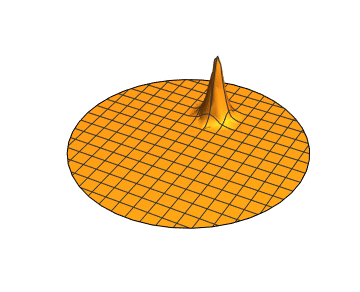
To have an internal obstacle just change the region:
region = RegionDifference[Disk[],
Rectangle[{-1/3, -1/3}, {1/3, -1/4}]];
sol = NDSolveValue[{D[u[t, x, y], {t, 2}] -
Laplacian[u[t, x, y], {x, y}] == 0,
DirichletCondition[u[t, x, y] == 0, True],
u[0, x, y] == 2*Exp[-125 ((x)^2 + (y - 0.5)^2)],
Derivative[1, 0, 0][u][0, x, y] == 0}, u, {t, 0, 2},
Element[{x, y}, region]]
Visualize:
ListAnimate[
Table[
Plot3D[sol[t, x, y], Element[{x, y}, region],
PlotRange -> {-0.75, 2}, AspectRatio -> Automatic, Boxed -> False,
Axes -> None, PlotPoints -> 33], {t, 0, 2, 1/25}],
SaveDefinitions -> True]
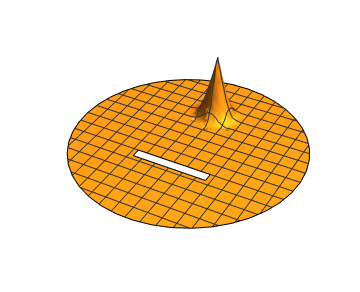
Also, you can find much more information on the wave equation by looking at the Acoustics in the Time Domain tutorial in the documentation system under PDEModels/tutorial/AcousticsTimeDomain
I adapted @Kuba's approach from this answer to generate a quick and dirty particle tracer.
(* Create and Discretize Region *)
region = RegionDifference[Disk[],
Rectangle[{-1/3, -1/3}, {1/3, -1/4}]];
R2 = RegionBoundary@DiscretizeRegion@region;
rdf = RegionDistance[R2];
rnf = RegionNearest[R2];
(* Time Increment *)
dt = 0.001;
(* Collision Margin *)
margin = 1.05 dt;
r0 = 1000;
(* Starting Point for Emission *)
sp = {0, 0};
(* Conditional Particle Advancer *)
advance[r_, x_, v_, c_] :=
Block[{xnew = x + dt v}, {rdf[xnew], xnew, v, c}] /; r > margin
advance[r_, x_, v_, c_] :=
Block[{xnew = x , vnew = v, normal = Normalize[x - rnf[x]]},
vnew = Normalize[v - 2 v.normal normal];
xnew += dt vnew;
{rdf[xnew], xnew, vnew, c + 1}] /; r <= margin
Now, we can run the simulation and create an animation at every 50 time steps.
nparticles = 1000;
ntimesteps = 5000;
tabres = Table[
NestList[
advance @@ # &, {rdf[sp],
sp, {Cos[2 Pi #], Sin[2 Pi #]} &@RandomReal[], 0},
ntimesteps], {i, 1, nparticles}];
frames = Table[
RegionPlot[R2, Epilog -> (Disk[#, 0.01] & /@ tabres[[All, i, 2]]),
AspectRatio -> Automatic], {i, 1, ntimesteps, 50}];
ListAnimate@frames
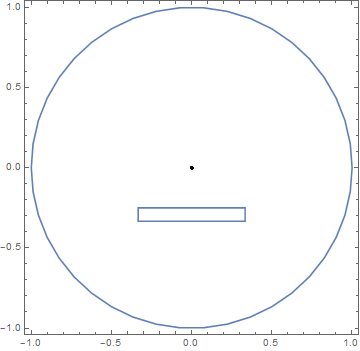
@user21's solution is very impressive. However, it isn't quite what I was looking for. This is because of the interaction between the waves. They are acting - well - like waves. This means we have a linear addition of the waves. This was what the original question forbid ;) . We want a single wavefront to come from the centre of the sphere and watch what happens as it moves around objects. Imagine it is a single photon - and doesn't act like a water wave.
Of course, if we're talking about single photons - a raytracing solution would work. I've implemented one (inspired from here), however, again - it isn't what the original question is asking for. We want a single wavefront which spreads....
But, anyway, this is my ray-tracing attempt
With 3 photons:
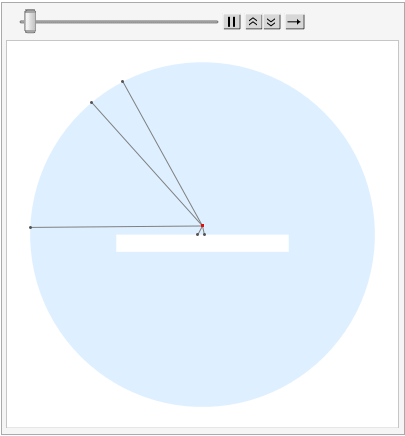
With 100 photons:
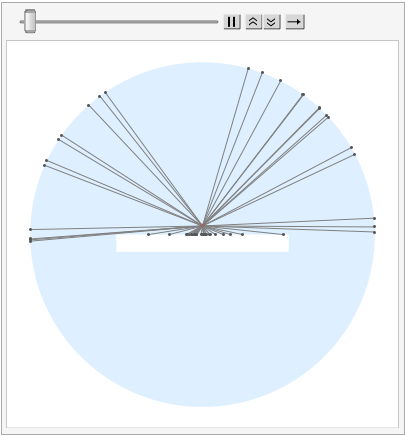
(* Line Intersection *)
LLI[vi_List] :=
With[{x1 = vi[[1, 1]], y1 = vi[[1, 2]], x2 = vi[[2, 1]],
y2 = vi[[2, 2]], x3 = vi[[3, 1]], y3 = vi[[3, 2]], x4 = vi[[4, 1]],
y4 = vi[[4,
2]]}, {-((-(x3 - x4) (x2 y1 - x1 y2) + (x1 - x2) (x4 y3 -
x3 y4))/((x3 - x4) (y1 - y2) + (-x1 + x2) (y3 -
y4))), (x4 (y1 - y2) y3 + x1 y2 y3 - x3 y1 y4 - x1 y2 y4 +
x3 y2 y4 +
x2 y1 (-y3 + y4))/(-(x3 - x4) (y1 - y2) + (x1 - x2) (y3 - y4))}]
(* Consider how we bounce *)
bounce2[{p0_, d0_, i0_}] :=
Module[{idxL, pL, validL, distL, i, p1, d1, bValid, dist, angleL,
angle}, idxL =
Position[Pi/2 < VectorAngle[d0, #] < Pi 3/2 Pi & /@ norm, True] //
Flatten;
pL = Table[LLI[{p0, p0 + d0, ##}] & @@ edge[[j]], {j, idxL}];
validL =
Table[! Or @@ (Greater[#,
1] & /@ (EuclideanDistance[#, pL[[i]]]/
length[[idxL[[i]]]] & /@ edge[[idxL[[i]]]])), {i,
Length@idxL}];
distL = EuclideanDistance[#, p0] & /@ pL;
angleL =
Table[VectorAngle[norm[[idxL[[i]]]], pL[[i]] - p0], {i,
Length@idxL}];
{i, p1, bValid, angle, dist} =
Select[Transpose@{idxL, pL, validL, angleL,
distL}, (#[[3]] && #[[4]] > Pi/2) &] //
MinimalBy[#, Last] & // #[[1]] &;
d1 = (ReflectionTransform[RotationTransform[-Pi/2]@(-norm[[i]]),
p1]@p0 - p1) // Normalize;
{p1, d1, i}]
(* Give our boundaries *)
boundary1 = CirclePoints[2, 100];
edge1 = Table[
RotateRight[boundary1, i][[;; 2]], {i, Length@boundary1}];
length1 = EuclideanDistance @@ # & /@ edge1;
norm1 = Normalize@(RotationTransform[Pi/2]@(#[[2]] - #[[1]])) & /@
edge1;
boundary2 = {{-1, -0.2}, {1, -0.2}, {1, 0}, {-1, 0}};
edge2 = Table[
RotateRight[boundary2, i][[;; 2]], {i, Length@boundary2}];
length2 = EuclideanDistance @@ # & /@ edge2;
norm2 = -Normalize@(RotationTransform[Pi/2]@(#[[2]] - #[[1]])) & /@
edge2;
boundary = Join[boundary1, boundary2];
edge = Join[edge1, edge2];
length = Join[length1, length2];
norm = Join[norm1, norm2];
photons = 3;
bounces = 100;
g = ConstantArray[{}, photons];
For[i = 1, i <= photons, i++,
p0 = {0, 0.1};
d0 = {Cos@#, Sin@#} &@RandomReal[{0, 2 Pi}];
r = NestList[bounce2, {p0, d0, 0}, bounces];
p = r[[All, 1]];
g[[i]] =
Table[Graphics[{FaceForm[LightBlue], EdgeForm[], Gray,
Line@p[[;; j]], Darker@Gray, Point@p[[;; j]], Red,
Point@p[[1]]}], {j, 2, Length@r}];
]
surface =
Graphics[{{FaceForm[LightBlue], Polygon@boundary1}, FaceForm[White],
Polygon@boundary2}]
animate = Table[Show[surface, g[[;; , {i}]]], {i, 1, bounces}];
ListAnimate[animate]
This isn't a complete solution as I really looking for the propagation of the circles around the sphere.